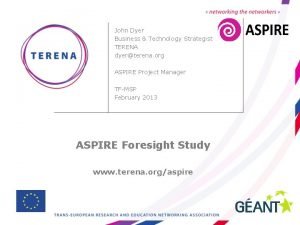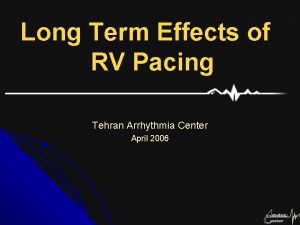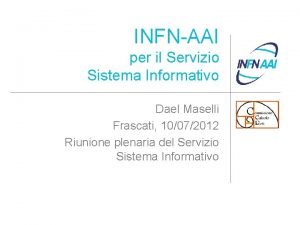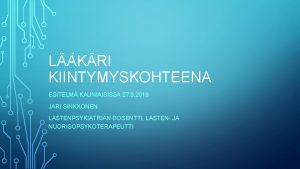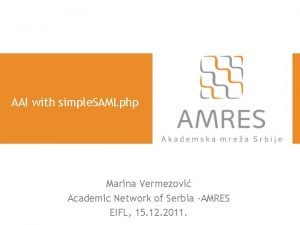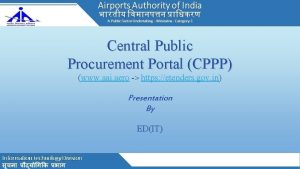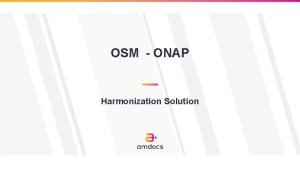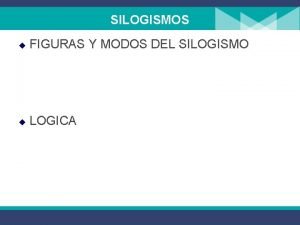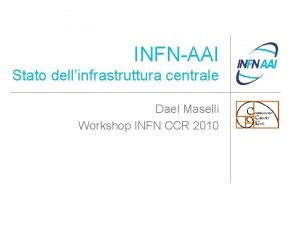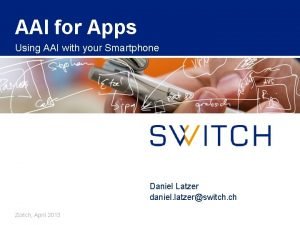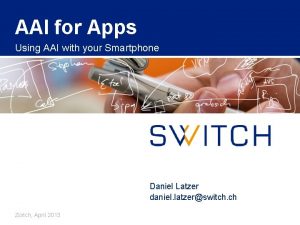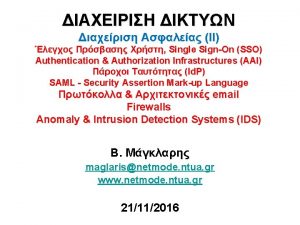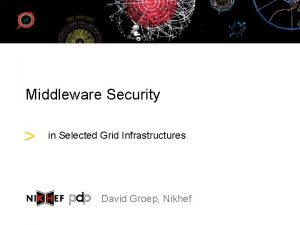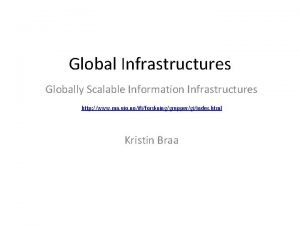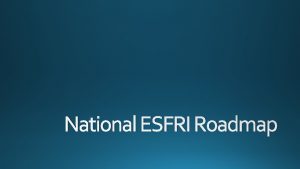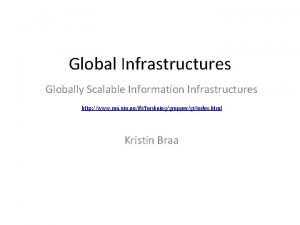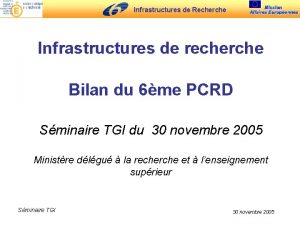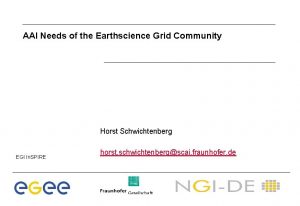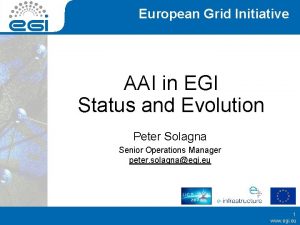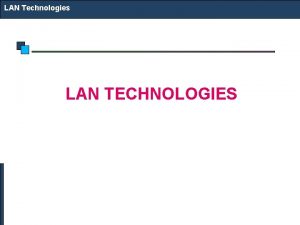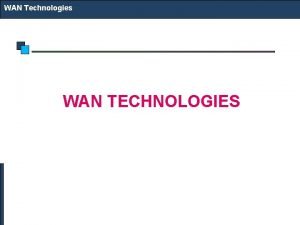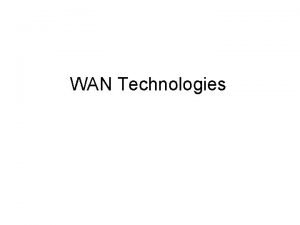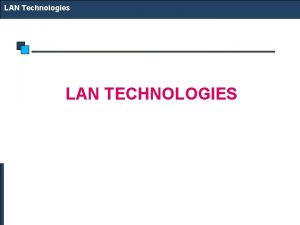Grid Technologies for AAI in Selected Grid Infrastructures




















































- Slides: 52

Grid Technologies for AAI* > in Selected Grid Infrastructures and using a Subset of the available technologies (2010) David Groep, Nikhef with graphics by many others from publicly available sources. . . based on the ISGC 2010 Security Middleware presentation

> > Grid is global > based around (dynamic) user communities not around their home organisations > that may live long or be over quickly > deal with compute, data, visualisation, services, and more > and can consist of staff, students, technicians, … > EGI-TF 10 NREN-Grids workshop Sept. 2010 2

> A Typical Grid Scenario > EGI-TF 10 NREN-Grids workshop Sept. 2010 3

> Non-interactive, autonomous work > EGI-TF 10 NREN-Grids workshop Sept. 2010 4

> Or via portals > Flexible portals acting on behalf of the user, > work-flow portals with canned applications > turn-around: minhours > EGI-TF 10 NREN-Grids workshop Sept. 2010 5

> What drove the Grid AAI model > Accommodate multiple sources for assertions > Auth. N vs. Auth. Z is a logical implementable separation > Accommodate delegation (disconnected operation) > Entities act on behalf of a user > Service providers do not know (or cannot fully trust) each other > Commensurate impact of resource compromise • compromise of small resource should have limited impact > Accommodate individual, independent researchers > collaboration without necessity to involve bureaucracy > Inspire enough trust for resource providers to relinquish peruser local registration and allow direct access to their systems > Has to work now (and has had to work since 2002!) > EGI-TF 10 NREN-Grids workshop Sept. 2010 6

> Authentication (vs. Authorization) Obtaining trustworthy unique, persistent ID Delegation and proxies ‘GRID’ SECURITY MECHANISM FOUNDATIONS AND SCOPE > EGI-TF 10 NREN-Grids workshop Sept. 2010 7

> A coordinated trust fabric: IGTF A ‘policy bridge’ infrastructure for authentication > Today there are 86 accredited authorities > From 54 countries or economic regions > Direct relying party (customer!) representation & influence > from countries … and major cross-national organisations > > > > EGI DEISA w. LCG TERENA PRAGMA (APGrid. PMA) Teragrid (TAGPMA) Open Science Grid (TAGPMA) > EGI-TF 10 NREN-Grids workshop Sept. 2010 8

> Authentication Policy Guidelines IGTF established a single trust fabric, incorporating authorities using different techniques Common Elements · Unique Subject Naming · Identifier Association · Publication & IPR · Contact and incident response · Auditability Profiles · Classic PKI · · Real-time vetting (F 2 F or TTP) 13 months life time · SLCS · · Existing Id. M databases 100 k – 1 Ms life time · MICS · · · Id. M Federation with F 2 F managed, revocable, identity 13 months max https: //www. eugridpma. org/guidelines/ > EGI-TF 10 NREN-Grids workshop Sept. 2010 9

> Hiding PKI internals from the User > PKI is a great transport technology … … but a no-go for most users > How to hide the PKI internals? > do away with multiple ID checks by leveraging federations (TERENA TCS, SWITCHaai, DFNaai) > hide credential management in client tools (j. Gridstart) > use offer credential management as a service (My. Proxy) > user does not see PKI that drives the Sept. 2010 infrastructure > EGI-TF 10 NREN-Grids workshop 11

> > > A Federated PKI Implementations: • DFN Grid CA • SWITCHaai SLCS • TERENA e. Science Personal CA • CI Logon (Q 4 2010) • ARCS CA (end 2010) Use your federation ID. . . to authenticate to a service. . . that issues a certificate. . . recognised by the Grid today Outdated Graphic from: Jan Meijer, UNINETT > EGI-TF 10 NREN-Grids workshop Sept. 2010 12

> Delegation RFC 3820 AUTOMATED TASKS, SERVICES, AND BROKERING > EGI-TF 10 NREN-Grids workshop Sept. 2010 13

> Distributed Services in Grid 3. Register (via RRS) Replica Manager Replica Catalog SRM-Client 1. DATA Creation 2. SRM- PUT Users Network transfer of DATA 4. SRMCOPY Tier 0 to Tier 1 5. SRM-GET SRM 6. Grid. FTP ERET (pull mode) Network transfer CASTOR Example file transfer services using managed third -party copy via the SRM protocol cache archive files stage files 7. SRMCOPY Tier 1 to Tier 2 Retrieve data for analysis 10. SRM-GET 8. SRM-PUT SRM 9. Grid. FTP ESTO (push mode) Network transfer d. Cache Enstore archive files FNAL Tier 1 CERN Tier 0 SRM-Client Network transfer of DATA Tier 2 Storage Tier 2 Center SRM graphic: Timur Perelmutov and Don Petravick, Fermilab, US Example automatic workload distribution across many sites in a Grid > EGI-TF 10 NREN-Grids workshop Sept. 2010 14

> Delegating rights and privileges > EGI-TF 10 NREN-Grids workshop Sept. 2010 15

> Delegation – why break the recursion? > Mechanism to have someone, or some-thing – a program – act on your behalf > as yourself > with a (sub)set of your rights > Essential for the grid model to work > since the grid is highly dynamic and resources do not necessarily know about each other > only the user (and VO) can ‘grasp’ the current view of their grid > GSI-PKI (and now finally some recent SAML) define > GSI (PKI) through ‘proxy’ certificates (see RFC 3820) > SAML through Subject Confirmation, linking to at least one key or name > EGI-TF 10 NREN-Grids workshop Sept. 2010 16

> Delegation, but to whom? > RFC 3820 – dynamic delegation via ‘proxy certs’ > Subject name of the proxy derived from issuer “/DC=org/DC=example/CN=John Doe/CN=24623/CN=535431” is a proxy for user “/DC=org/DC=example/CN=John Doe” > Contains policy constraints on delegation > Auth. Z based on end-entity + embedded attributes&policies > with SAML, delegation can be to any Name. ID > in RFC 3820, EGI-TF 10 these are called ‘independent proxies’ NREN-Grids workshop Sept. 2010 > 17

> Verifying authentication and X. 509 > ‘Conventional’ PKI engines in *nix domain > Open. SSL, Apache mod_ssl, nss > Java JCE providers, such as Bouncy. Castle > Perl, Python usually wrappers around Open. SSL > With proxy support > Open. SSL (0. 9. 8+) > Globus Toolkit (C, Java) > g. Lite proxy. Verify library (LCMAPS) > g. Lite Trust. Manager on Java’s Bouncy. Castle > Grid. Site > and always ensure proxy policies are implemented & enforced > EGI-TF 10 NREN-Grids workshop Sept. 2010 18

> Community organisation Proxies and delegation with attributes: VOMS Authorization with VOMS: autonomous, GUMS Towards a multi-authority world USER COMMUNITY MODELS > EGI-TF 10 NREN-Grids workshop Sept. 2010 19

> Authorization: VO representations > VO*: directory (database) of members, groups, roles, attributes > based on identifiers issues at the Auth. N stage > Membership information is to be conveyed to the resource providers > configured statically, out of band > in advance, by periodically pulling lists VO (LDAP) directories > in VO-signed assertions pushed with the request: VOMS, Community Auth. Z Service > Push or pull assertions via SAML * this is the ‘EGI’ or e-Infrastructure sense of VO, representing users. Other definitions at times include resources providers, in a more vertically oriented ‘silo’ model > EGI-TF 10 NREN-Grids workshop Sept. 2010 20

> VOMS: the ‘proxy’ as a container Virtual Organisation Management System (VOMS) > developed by INFN for EU Data. TAG and EGEE > used by VOs in EGI, Open Science Grid, NAREGI, … > push-model signed VO membership tokens > using the traditional X. 509 ‘proxy’ certificate for trans-shipment > fully backward-compatible with only-identity-based mechanisms > EGI-TF 10 NREN-Grids workshop Sept. 2010 21

> VOMS model > EGI-TF 10 NREN-Grids workshop Sept. 2010 22

> GUMS model > VO configuration replicated locally at the site > Here, pushed VOMS attributes are advisory only synchronizes > EGI-TF 10 NREN-Grids workshop Graphic: Gabriele Garzoglio, FNAL 23 Sept. 2010

> Attributes from many sources > In ‘conventional’ grids, all attributes assigned by VO > but there are many more attributes, and some of these may be very useful for grid structure was not too much different! > EGI-TF 10 NREN-Grids workshop Sept. 2010 24

> Towards a multi-authority world (AAI) Interlinking of technologies can be done at various points 1. Authentication: linking (federations of) identity providers to the existing grid Auth. N systems > ‘Short-Lived Credential Services’ translation bridges 2. 3. 4. > Populate VO databases with UHO Attributes Equip resource providers to also inspect UHO attributes Expressing VO attributes as function of UHO attributes and most probably many other options as well … Leads to assertions with multiple Lo. As in the same decision > thus all assertions should carry their Lo. A > expressed in a way that’s recognisable > and the Lo. A attested to by ‘third parties’ (e. g. the federation) > EGI-TF 10 NREN-Grids workshop Sept. 2010 25

> Attributes from multi-authority world > Linking two worlds example – > VASH: ‘VOMS Attributes from Shibboleth’ > Populate VOMS with generic attributes > Part of g. Lite (SWITCH) http: //www. switch. ch/grid/vash/ > EGI-TF 10 NREN-Grids workshop Graphic: Christoph Witzig, SWITCH 26 Sept. 2010

> Putting home attributes in the VO > Characteristics > The VO will know the source of the attributes > Resource can make a decision on combined VO and UHO attributes > but for the outside world, the VO now has asserted to the validity of the UHO attributes – over which the VO has hardly any control > EGI-TF 10 NREN-Grids workshop Sept. 2010 27

> Attribute collection ‘at the resource’ graphic from: Chistoph Witzig, SWITCH, GGF 16, February 2006 Graphic: the Grid. Shib project (NCSA) http: //gridshib. globus. org/docs/gridshib/deploy-scenarios. html > Characteristics > > The RP (at the decision point) knows the source of all attributes but has to combine these and make the ‘informed decision’ is suddenly faced with a decision on quality from different assertions needs to push a kind of ‘session identifier’ to select a role at the target resource > EGI-TF 10 NREN-Grids workshop Sept. 2010 28

> Example: running compute jobs The Meaning of Attributes: Unix domain mapping ACCESS CONTROL FOR COMPUTE > EGI-TF 10 NREN-Grids workshop Sept. 2010 29

> Job Submission Today User submits his jobs to a resource through a ‘cloud’ of intermediaries Direct binding of payload and submitted grid job • job contains all the user’s business • access control is done at the site’s edge • inside the site, the user job should get a specific, site-local, system identity > EGI-TF 10 NREN-Grids workshop Sept. 2010 30

> But basic yes-no does not get you far > If yes, what are you allowed to do? > Credential mapping via obligations, e. g. unix account, to limit what a user can do and disambiguate users > Intended side effects: allocating or creating accounts. . . or virtual machines, or. . . > Limit access to specific (batch) queues, or specific systems > Additional software needed > Interpreting policy and constraints > Handling ‘obligations’ conveyed with a decision > e. g. LCMAPS: account mappings, AFS tokens, Argus call-out Argus: pluggable obligation handlers per application • and interpret (pre-provisioned) policies applicable to a transaction/credential > EGI-TF 10 NREN-Grids workshop Sept. 2010 31

> To the Unix world: Problem Identity C=IT/O=INFN VOMS /L=CNAF pseudo/CN=Pinco Pallacert /CN=proxy VOMS + other attributes pvier 001: x: 43401: 2029: Pool. Account VL-e P 4 no. 1: /home/pvier 001: /bin/sh run as root credential: …/CN=Pietje Puk > Unix does not talk Grid, so translation is needed between grid and local identity 1. translation has to happen somewhere 2. something needs to do that > EGI-TF 10 NREN-Grids workshop run as target user uid: ppuk 001 uid. Number: 9620132 Sept. 2010

> What does this all mean? > Attribute interpretation is much more than mere mapping > what do the attributes mean, and do all VOs mean similar things with the same kinds of attributes? > Is the order in which the attributes are presented important? > Can the same bag of attributes (or same priority) be used for both compute and data access? > How do changing attributes reflect access rights on persistent storage, if the VO evolves its attribute set? > Is there a driving use case by RPs (VO, sites) for an attribute? > only then makes harmonization any sense… > Let RPs (co-)define requirements, not only Id. Ps, CAs, or VOs! > EGI-TF 10 NREN-Grids workshop Sept. 2010 33

> Policy from multiple sources Frameworks AUTHORIZATION FRAMEWORKS > EGI-TF 10 NREN-Grids workshop Sept. 2010 42

> A multi-authority world > Authorization elements (from OGSA 1. 0) > EGI-TF 10 NREN-Grids workshop Graphic: OGSA Working Group 43 Sept. 2010

> Control points Container based In-service based > Single control point > Agnostic to service semantics > Many control points > Authorization can depend on requested action and resource > EGI-TF 10 NREN-Grids workshop Sept. 2010 44

> Frameworks > (chain of) decision making modules controlling access > Loosely or tightly coupled to a service or container > Generic ‘library’, or tied into the service business logic example: GT 4/Java > EGI-TF 10 NREN-Grids workshop Graphic: Frank Siebenlist, Globus and ANL 45 Sept. 2010

> Example framework implementations > PRIMA-SAZ-GUMS-g. Plazma suite > > > Globus Toolkit Authorization Framework Site Access Control ‘LCAS-LCMAPS’ suite g. Lite Argus Grid. Site & GACL. . . interop . . . and don’t forget ‘native’ service implementations > EGI-TF 10 NREN-Grids workshop Sept. 2010 46

> Different frameworks > Each framework has > own calling semantics (but may/will interoperate at the back) > its own form of logging and auditing > Most provide > Validity checking of credentials > Access control based on Subject DN and VOMS FQANs > Subject DN banning capability > And some have specific features, e. g. , > > Capability to process arbitrary ‘XACML’ (composite) policies Calling out to obtain new user attributes Limiting the user executables, or proxy life time, . . . allow embedding inside the application business logic > EGI-TF 10 NREN-Grids workshop Sept. 2010 47

> Centralizing Authorization in the site Available middleware: GUMS and SAZ, Argus, . . . Interoperability through common protocols ACCESS CONTROL MANAGEMENT SYSTEMS > EGI-TF 10 NREN-Grids workshop Sept. 2010 48

> Embedded controls: CE, d. Cache, . . . voms-proxy-init Proxy with VO Membership | Role attributes SAML 2 XACML 2 interop protocol GUMS, SCAS, &c srmcp DATA SRM Server SRM Callout Grid. FTP Server Grid FTP Callo g. PLAZ ut MA SRM-d. Cache PRIMA SAML Client g. PLAZMA Lite Authorizat ion Service g. PLAZMA Lite gridmapfile dcache. kp SAML response https/SO AP SAML query Storage Authorizat ion Service If authorized, get username User Authorization Record Storage metadat a Get storage authz for this username GUMS Identity Mapping Service Graphic: Frank Wurthwein, CHEP 2006 Mumbai wd > EGI-TF 10 NREN-Grids workshop Sept. 2010 49

> Access Control at the Service Most prevalent solution today … Pros: > services independent and have no common failure mode > quick and easy to develop and deploy Con: > no single ‘Big Red Button’ > difficult auditing… > risk of inconsistency > 50 EGI-TF 10 NREN-Grids workshop Sept. 2010

> Centralizing decentralized Access Control Aim: support consistently > policy management across services > quick banning of bad users > coordinated common user mappings (if not WN-local) Different options to implement it … > Regular site management tools (CFengine, Quattor, etc) > Addresses site-wide banning in a trivial and quick way > but appears ‘out of band’ and works only for managed installations > One of the ‘central authorization services’ > these can be department-central, site-central, but even grid-wide or global! > some to choose from in Grid: Argus, GUMS, … > like ‘inverse’ Id. P, centrally processing assertions for Auth. Z instead of making … > 51 EGI-TF 10 NREN-Grids workshop Sept. 2010

> Centralizing access control in M/W off-site policy site-central service * of course, central policy and distributed per-WN mapping also possible! > 52 EGI-TF 10 NREN-Grids workshop Sept. 2010

> Key Elements for interop > Common communications profile > Agreed on use of SAML 2 -XACML 2 > http: //www. switch. ch/grid/support/documents/xacmlsaml. pdf Graphic: Gabriele Garzoglio, FNAL Subject S requests to perform Action A on Resource R within Environment E CE / SE / WN Gateway PEP Grid Site XACML Request Site Services PDP XACML Response Decision Permit, but must fulfill Obligation O EGI-TF 10 NREN-Grids workshop Sept. 2009 53 > Common attributes and obligations profile > List and semantics of attributes sent and obligations received between a ‘PEP’ and ‘PDP’ > Now at version 1. 1 > http: //cd-docdb. fnal. gov/cgi-bin/Show. Document? docid=2952 > http: //edms. cern. ch/document/929867 Sept. 2010 > EGI-TF 10 NREN-Grids workshop 53

> GUMS and SAZ VO Grid Site PDP Site Services VOMS 4 Gatekeeper g. LExec g. Plazma Prima 8 8 Batch System Schedule Pilot OR Job Access Data (UID/GID) Legend WN SRM Submit Pilot OR Job (UID/GID) Submit request with voms-proxy Not Officially In OSG PEPs CE Storage Auth. Z Components 6 SE get voms-proxy 5 7 Is Auth? Yes / No 3 ID Mapping? Yes / No + User. Name 1 2 SAZ GUMS synch register VOMRS synch Pilot SU 10 Job (UID/GID) 9 VO Management Services graphic: Dave Dykstra, Fermi National Accelerator Laboratory, CHEP, March 2009 > EGI-TF 10 NREN-Grids workshop Sept. 2010 54

> Argus services and daemons > Administration Point Formulating rules through CLI and/or file-based input > Decision Point Evaluating a request from a client based on the rules > Enforcement Point Thin client part and server part: all complexity in server part > Runtime Execution Environment Under which env. must I run? (Unix UID, GID, …) Graphic: Christoph Witzig, SWITCH and EGEE > EGI-TF 10 NREN-Grids workshop Sept. 2010 55

> Argus service graphic: MJRA 1. 4 (EGEE-II) g. Lite security architecture, Oct 2008, Christoph Witzig > EGI-TF 10 NREN-Grids workshop Sept. 2010 56

> Interoperability achievements graphic: Gabriele Garzoglio, FNAL > EGI-TF 10 NREN-Grids workshop Sept. 2010 57

> Capabilities (Argus as an example) > Enables/eases various authorization tasks: > Banning of users (VO, WMS, site, or grid wide) > Composition of policies – e. g. CERN policy + experiment policy + CE policy + OCST policy + NGI policy=> Effective policy > Support for authorization based on more detailed information about the job, action, and execution environment > > Support for authorization based on attributes other than FQAN Support for multiple credential formats (not just X. 509) Support for multiple types of execution environments Virtual machines, workspaces, … https: //twiki. cern. ch/twiki/bin/view/EGEE/Authorization. Framework > EGI-TF 10 NREN-Grids workshop Sept. 2010 58

> Summary and last words FROM HERE? > EGI-TF 10 NREN-Grids workshop Sept. 2010 64

> What Grid AAI does for you today > Accommodates multiple sources for assertions > Auth. N vs. Auth. Z separated, with multiple VO membership off same ID > With the ‘PKI bits’ being cleverly hidden from the user > Accommodate delegation (disconnected operation) > Entities act on behalf of a user > services like My. Proxy and SLCS make it transparent even for portals and long-running jobs > Accommodate individual, independent researchers > even though federations will aid 99% percent, full coverage will be rare > EGI demonstrates that the mechanisms and associated policies and standards convinced 300+ resource providers grid is trustworthy enough 2010 need to 65 > Users actually see a. NREN-Grids single workshop interface (VO), and no. Sept. longer > EGI-TF 10

> Having left out a lot of things. . . are there any QUESTIONS? > EGI-TF 10 NREN-Grids workshop Sept. 2010 66
 European strategy forum on research infrastructures
European strategy forum on research infrastructures Aai aspire
Aai aspire Aai pacing
Aai pacing Infn aai login
Infn aai login Jari sinkkonen vastaanotto
Jari sinkkonen vastaanotto Samlphp
Samlphp Ess portal aai
Ess portal aai Onap vs mano
Onap vs mano Premisa mayor
Premisa mayor Dael maselli
Dael maselli Lga vs pga socket
Lga vs pga socket Bris för vuxna
Bris för vuxna Mat för idrottare
Mat för idrottare Publik sektor
Publik sektor Vad är ett minoritetsspråk
Vad är ett minoritetsspråk Ledarskapsteorier
Ledarskapsteorier Datorkunskap för nybörjare
Datorkunskap för nybörjare Antikt plagg i rom
Antikt plagg i rom Humanitr
Humanitr Rita perspektiv
Rita perspektiv Ministerstyre för och nackdelar
Ministerstyre för och nackdelar Redogör för vad psykologi är
Redogör för vad psykologi är Nationell inriktning för artificiell intelligens
Nationell inriktning för artificiell intelligens Bästa kameran för astrofoto
Bästa kameran för astrofoto Sju principer för tillitsbaserad styrning
Sju principer för tillitsbaserad styrning Geometriska former i förskolan
Geometriska former i förskolan Lyrik
Lyrik Nyckelkompetenser för livslångt lärande
Nyckelkompetenser för livslångt lärande Datumr
Datumr Tidbok för yrkesförare
Tidbok för yrkesförare Orubbliga rättigheter
Orubbliga rättigheter Big brother rösta
Big brother rösta Verktyg för automatisering av utbetalningar
Verktyg för automatisering av utbetalningar Kyssande vind
Kyssande vind Vem räknas som jude
Vem räknas som jude Aktiv expektans
Aktiv expektans Ro i rom pax
Ro i rom pax Stig kerman
Stig kerman Shingelfrisyren
Shingelfrisyren Ledningssystem för verksamhetsinformation
Ledningssystem för verksamhetsinformation Tack för att ni har lyssnat
Tack för att ni har lyssnat Matematisk modellering eksempel
Matematisk modellering eksempel Ekologiskt fotavtryck
Ekologiskt fotavtryck Centrum för kunskap och säkerhet
Centrum för kunskap och säkerhet Läkarutlåtande för livränta
Läkarutlåtande för livränta Shaktismen
Shaktismen Inköpsprocessen steg för steg
Inköpsprocessen steg för steg Påbyggnader för flakfordon
Påbyggnader för flakfordon Egg för emanuel
Egg för emanuel Strategi för svensk viltförvaltning
Strategi för svensk viltförvaltning A gastrica
A gastrica R formel
R formel Rutin för avvikelsehantering
Rutin för avvikelsehantering

